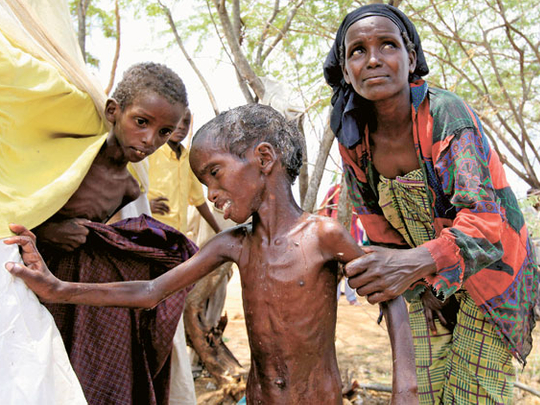
Where there are beasts, there is life, goes a saying in Somalia. Half of its people depend on livestock for their survival. This year they will export record numbers of animals. That seems improbable given that a famine is raging in south Somalia, which has seen over a million animals die of hunger and thirst. But the grazing in other parts of Somalia, especially the north, has been excellent and demand for livestock from abroad has never been higher. After banning Somali sheep and goats for many years, Jeddah in Saudi Arabia has once again declared them welcome.
For the first time since the collapse of Somalia as a unitary state in 1991, Saudi and Lebanese traders have ventured into the local livestock markets. Goats are mainly exported to Makkah for the annual Haj.
The UN's Food and Agriculture Organisation estimates that $250 million (Dh918 million)-worth of animals will leave the port of Berbera and its more ramshackle rival, Bossaso, in the seven weeks before the Haj in early November.
In the livestock market in Hargeisa, capital of the semi-autonomous region of Somaliland, sweaty goatherds press in on Adan Ahmad Deria, a trader. Hundreds of camels are being loaded onto lorries.
Deria nods to show that the price is fixed. "God willing," he says, "I will buy 800,000 goats and sheep this year." That is $52 million of business, in cash, in a country where the economy has apparently collapsed.
Trade is set to grow further. Saudi Arabia wants to double its livestock imports from Somalia by 2013. The herders face fierce competition from Georgia, China and Paraguay, but halal butchers value the quality of Somali animals, which are raised by nomadic Muslims.
Economic growth
Though the region suffers from rampant piracy, it mainly affects international shipping rather than locals. Last month pirates captured a livestock ship in the waters off Bossaso; they were killed within hours by irate traders and herders. Meanwhile, hijacked foreign freighters litter the coastline undisturbed.
As parts of the economy grow, Somalis increasingly look to the diaspora for loans. Its members are prominent in gold and metal markets across Africa. Many excel at moving goods and money around. The once thriving fishing industry would be helped by investment in refrigerators, as would frankincense cultivation, which employs 10 per cent of the workers in Puntland, a breakaway region in the north.
None of this is to deny that the situation in south Somalia — the country's breadbasket — is anything other than dire. UN figures yet to be published suggest that 80,000 people may already have died as a result of the famine. More are certain to follow them to the grave. According to Somali aid workers from the hungriest areas, the situation is bad but improving. Forecasts for the coming rains are promising. Showers have already arrived in some places. Recovery will be a struggle, but apocalypse looks less likely now.
An American celebrity campaign, entitled "F — famine", emphasises that famines are man-made. That is unhelpfully vague but not necessarily wrong. In Somalia famine results from the strictures imposed by the Al Qaida-linked Al Shabab militia, which controls large parts of the south.
A drought has strained the entire region. But Kenya and Ethiopia have dealt with it much better than the ignorant and petty Al Shabab. They have been kicked out of Mogadishu, Somalia's ruined seaside capital, by African Union (AU) troops paid by America and the European Union.
Al Shabab are not yet defeated, but they have lost a lot of ground and support. The story of a 23-year-old farmer, Ahmad Mohammad, is typical. He fled his village of Bulamerer on the Shabelle river along with his heavily pregnant wife and one of their children.
They left two other children behind in the village with Mohammad's mother and his teenage brothers and sisters. The family's goats died of hunger. He fears his children might suffer the same fate. Still, he says he will not return home until Al Shabab have gone.
Now on the defensive, Al Shabab have taken actions as desperate as they are deadly. On October 4 they arranged a suicide bombing in Mogadishu which killed over 100 people. Most were students queuing up for scholarships to Turkey. The bomber, a teenager, recorded an interview before the attack in which he said of the victims, "They never think about the hereafter and about harassed Muslims."
The International Crisis Group, a research and lobby group, argues that a "European style centralised state, based on Mogadishu, is almost certain to fail".
Somali elders talk of free-spirited nomads "vomiting up" orders made far away. Devolving power to towns and clans — the linchpin of Somali society—would be better. But that too is risky. Further economic growth in northern Somalia is dependant on law enforcement— an unlikely prospect.
But with north Somalia recovering somewhat, while the south is mired in famine, one conclusion is inescapable. The Somalia of the past is gone. The southern breadbasket has fallen too far behind. Even though it may slowly be freed from control of militants, Mogadishu will only ever be the capital in name.





_resources1_16a4a15e910_small.jpg)



